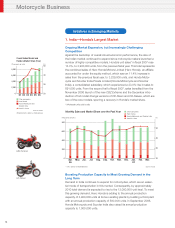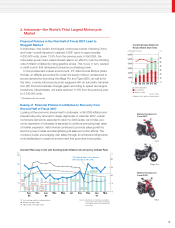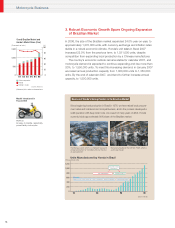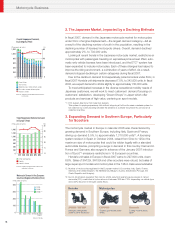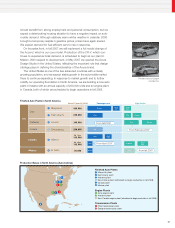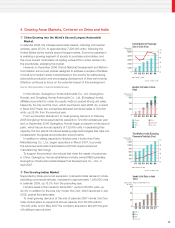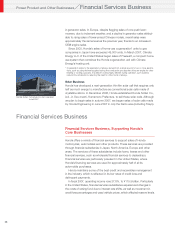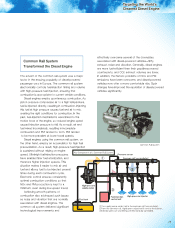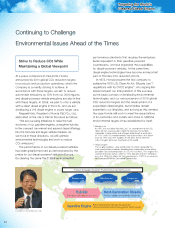Honda 2007 Annual Report Download - page 26
Download and view the complete annual report
Please find page 26 of the 2007 Honda annual report below. You can navigate through the pages in the report by either clicking on the pages listed below, or by using the keyword search tool below to find specific information within the annual report.
24
80
60
40
20
0
01 02 03 04 05 06
FFVs (only Brazil)
Gasoline vehicles
(Thousands
of units)
Honda’s Unit Sales
(Year)
3,000
2,000
1,000
0
01 02 03 04 05 06
Brazil
Argentina
Venezuela
Chile
Colombia
Equador
Peru
Honda’s share
6
4
2
0
Source: Global Insight
The South American Automobile
Market
(Including Commercial Vehicles)
(Thousands
of units) (%)
Thailand
Indonesia
Malaysia
The Philippines
0 400200 600500300100 700
05
06
05
06
05
06
05
06
Source: Global Insight
Honda
Other manufacturers
Total Honda Unit Sales in Key
ASEAN Countries (Year)
(Thousands of units)
Automobile Business
ePolitical Uncertainty and Natural Disaster Affects Demand in the
ASEAN Market
In the key ASEAN countries, such factors as soaring gasoline prices and
rising interest rates, as well as political instability in Thailand, caused the
automobile market to shrink.
In Indonesia, Honda’s sales in fiscal 2007 fell compared with the preced-
ing year affected by its economical situation, but strong sales performance
by the new Civic prompted year-on-year increases in Honda’s sales in
Thailand and Malaysia. Introduced into each of these markets in the second
half of fiscal 2007, the new CR-V registered brisk sales. To expand localized
production, in April 2007 we began the production in Thailand of camshafts,
connecting rods, crankshafts and other engine parts that require
sophisticated technologies.
5. Expanding Market Demand and the Growth of
Alternative Fuel (Ethanol) Vehicles in Brazil
Brazil, the largest market in South America, is experiencing robust economic
growth. Buoyed by such factors as rising incomes and falling interest rates,
total demand in calendar 2006 (excluding large trucks and buses), reached
approximately 1,830,000 units, up 13.1% from the previous year. As market
expansion is expected to continue, we anticipate total demand growth in
calendar 2007 of more than 15%, to 2,110,000 units.
In fiscal 2007, Honda’s unit sales rose 18.0%, to 67,000 units. Sales of
the new Civic, which went on sale in April 2006, were extremely favorable.
The Expanding Market for Flexible Fuel Vehicles (FFVs)
Following the first oil shock in the latter 1970s, the Brazilian government
began promoting ethanol fuels as an alternative to petroleum fuels. The mar-
ket for FFVs, which can run on a mixture of ethanol and gasoline—and is
less expensive than gasoline—has expanded to the point where as of March
2007, more than 80% of passenger cars were FFVs. In November 2006,
Honda introduced the Civic FFV, followed by the Fit FFV in December.
In fiscal 2008, we expect favorable sales of the Civic and the sale of FFVs
to raise unit sales approximately 25% from the previous year and are
expanding supply capacity in preparation. In January 2007, Honda raised
annual production capacity from 50,000 units to 80,000 units. Midway
through calendar 2007, we expect to further raise this level to 100,000 units.
100
80
60
40
20
003 04 05 06
82.8%
07
Mar.
(%)
Source: ANFAVEA
Percentage of Vehicles in Brazil that are FFVs
FFV
Gasoline
Passenger cars + commercial vehicles
(Excluding large trucks and buses)


